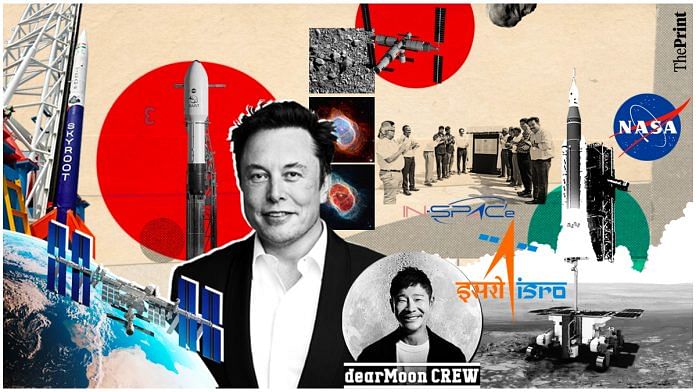Bengaluru: The space sector is growing faster than ever before, both in government-funded planetary exploration projects as well as private missions. ThePrint explores the top ten global developments in space and astronomy in 2022.
Private space tourism
In March, June and August, Jeff Bezos’s aerospace company Blue Origin’s New Shepard launched six passengers each in suborbital flights. In April, the very first all-private crew from the US flew to the International Space Station (ISS) and NASA has already signed a contract with the same company to take a second crew to the space station.
Japanese billionaire Yusaku Maezawa, who had visited the ISS as a tourist in December last year, announced his crew for a private mission to the moon.
James Webb Space Telescope
NASA’s James Webb Space Telescope, the most powerful telescope built to date, capable of seeing light from the earliest galaxies, began operations early this year.
In July, the very first images captured by the telescope were released to the public, revealing breathtaking views of galaxy clusters, distant galaxies pulling at each other, and star-forming regions millions and billions of light years away.
Also Read: Has space become more science fiction than science? Why it’s important in your daily life
India’s private sector boom
In 2022, the Indian private space sector saw a series of missions and launches, thanks to ISRO’s nodal agency IN-SPACe that facilitated access and collaboration with ISRO technology.
India’s first private rocket was launched by ISRO from its sounding rocket launch pad, while the country’s first private launchpad was inaugurated at Sriharikota.
China’s space station
China completed its Tiangong space station by adding its laboratory modules in July and October. The space station has already had three crewed missions and is currently inhabited.
The Tiangong station comprises the core module where the crew live, as well as two science labs, a dockable lifeboat, and robotic cargo ships.
Space debris
With increasing satellites in orbit around the earth, there is accumulation of space junk or debris — discarded parts of rockets, non-functioning satellites, pieces from other satellites, etc. This is expected to become a problem in the future, leading many concerned to take action.
In January, a Chinese satellite robotically grabbed an unused satellite and flung it into a higher orbit with lower risk.
In March, human space debris in the form of a discarded Long March 3C rocket from China, hit the lunar surface, creating a double crater.
Artemis-1
NASA resumed space missions to the moon with Artemis 1, the first in a series of Artemis missions that aim to establish human presence on the moon after a gap of over 70 years.
The uncrewed mission was launched in November, with the Orion space capsule orbiting Earth and flying around the moon, before returning to Earth again. The mission lasted 25 days.
Goodbye to Mars missions
In 2022, two Mars missions communicated with Earth for the last time.
ISRO’s Mars Orbiter Mission or Mangalyaan lost communication with Earth in April after a “long eclipse”, presumably unable to get enough sunlight to charge its solar panels and correct course. The mission was declared over in October, eight years after it entered into orbit around Mars. It was a technology demonstrator designed to last a minimum of six months, but lasted much longer, as is the norm with spacecraft.
NASA’s InSight lander ceased operations in December this year after accumulation of too much dust. The lander provided information about marsquakes and the planet’s interior.
A successful planetary defence experiment
NASA’s DART mission, which was launched in 2021 as a planetary defence experiment, headed towards the asteroid Dimorphos and successfully impacted its moon Didymos, changing the course of its orbit.
The success was announced in September and early results of orbit observation in December indicated that the impact shortened the orbit of the moon by 33 minutes.
A black hole in centre of Milky Way
In May, as a result of intensive, multi-institute, multi-national, five-year collaborative work, the very first image of the supermassive black hole at the centre of the Milky Way was released. The Event Horizon Telescope Collaboration captured the image of Sagittarius A* (Sgr A*), and the results are the first direct evidence of the existence of this supermassive black hole that the entire galaxy revolves around.
Effects of Russia’s invasion on Ukraine
When Russia invaded Ukraine in 2022, many countries imposed international sanctions on it, bringing to a halt multiple space activity collaborations.
Many Soyuz launches to the ISS were called off, and Russian space agency Roscosmos removed the American and Japanese flags from the Soyuz rocket design.
The Rosalind Franklin rover to Mars, a part of the Europe-Russia joint mission ExoMars 2022, was scheduled to launch in March, but the launch was suspended. The German-Russian space telescope mission, Spektr-RG, was also suspended.
Russia also announced that it would stop supplying rocket engines to the US.
(Edited by Geethalakshmi Ramanathan)
Also Read: Alzheimer’s to asthma, scientists have a new method to crack diseases. And it’s in space






